Gruul in Foundations
When you follow online discussions about the Foundations drafts, you’ll often hear that green is the weakest color. It’s true that green has the worst performing stats in the format, but that doesn’t mean you should avoid it entirely. In fact, red/green is one of the stronger archetypes in Premier Draft. In this article, we’ll take a look at what makes Gruul so strong and how you can get an edge when drafting it.
Green in Foundations
As you can see in this chart, green is by far the least played color in Foundations with a share of only 13.7%.
The average win rate of green decks is 53.9%, which while being the lowest overall, is still only 0.5% worse than the average win rate of all decks.
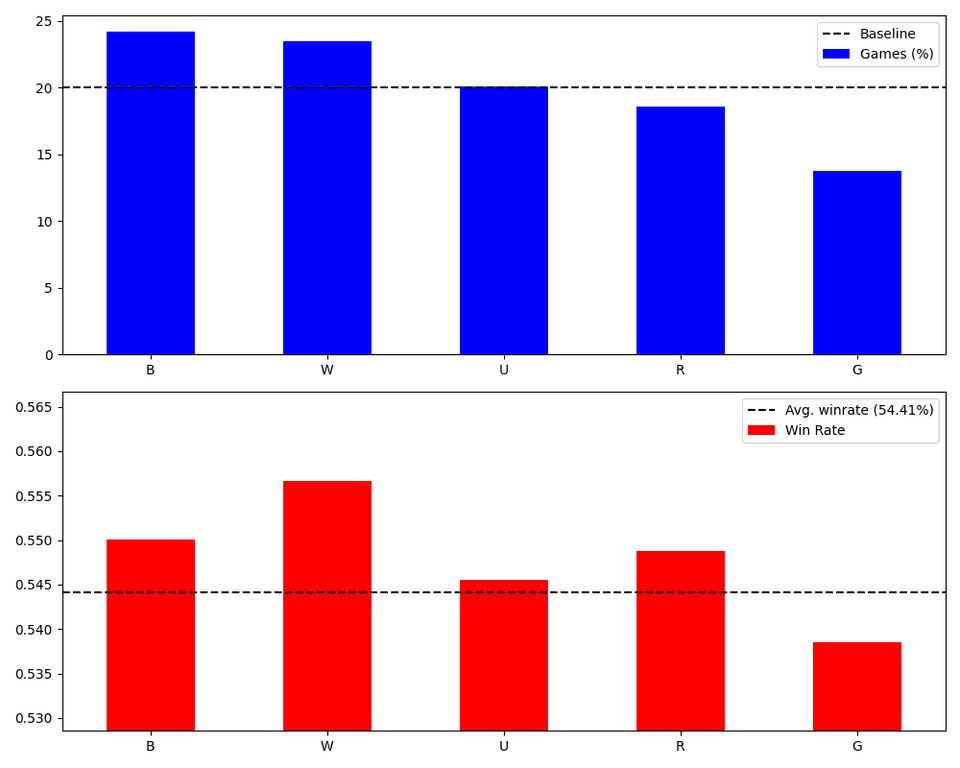
Comparing the first and second week of the format, we see that the trend of green being the least played color continues.
Players seem to have caught on to the fact that green is under-performing and are trying to avoid it.
Since draft is a zero-sum game, this means that green is more often open and committing to it can be rewarding.
We see this in the following chart, which shows a substantial increase in greens’ win rate from 53.7% in the first week to 54.2% in the second week.
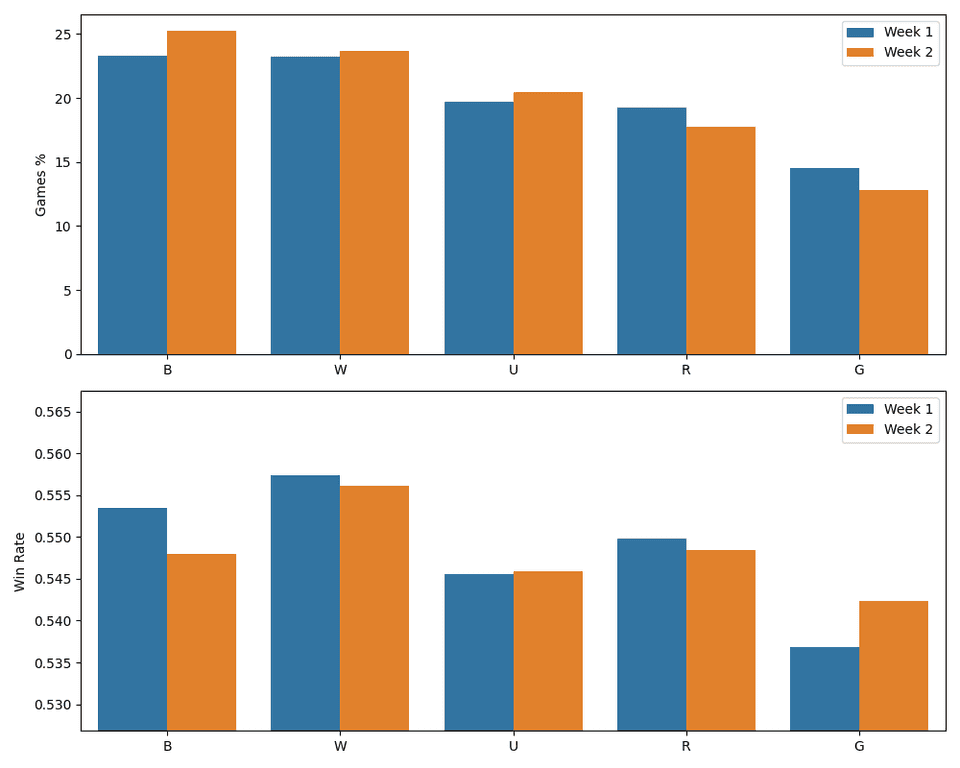
So to sum up, as more players are avoiding green the win rate of green decks is clearly increasing. This is a great opportunity for you to get an edge in your drafts when you can identify that green is open and reap the rewards while the letting the other players fight over the other colors.
Red/Green is the best green deck
Now that we’ve seen that we can leverage players’ aversion to green, let’s take a look at the different two-color archetypes.
The following chart shows each two-color archetype’s popularity and win rate sorted by how often they are played.
In accordance with the previous findings, we see that the four least played archetypes are all green.
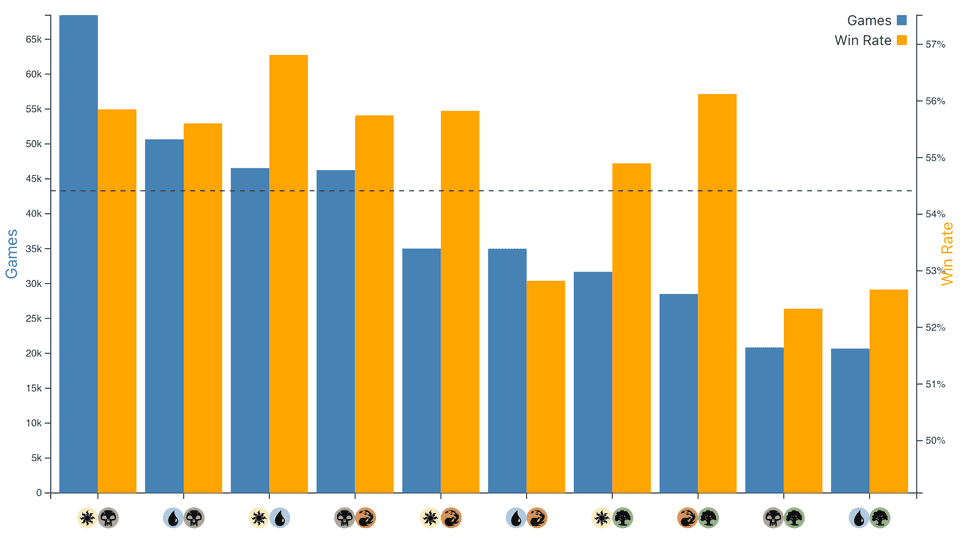
Surprisingly though we can see that red/green is the second best performing archetype with 56.1%, right after white/blue. So let’s have a look what makes Gruul work.
Gruul does not want to splash
Foundations in general is a format where you want to stick to two colors, but for Red/Green this is especially true.
This chart shows the win rate of each archetype with and without splashing.
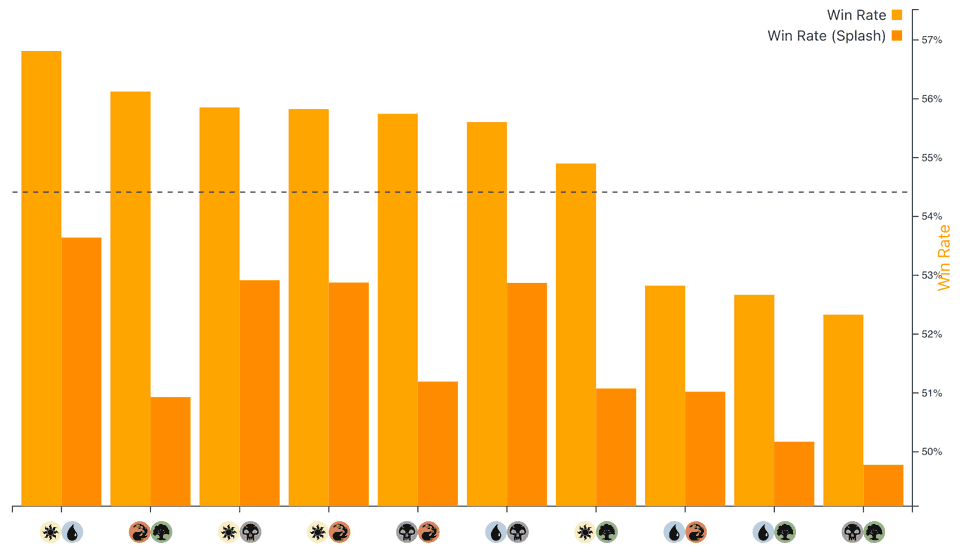
PSA: Looking at archetype card data at 17Lands
This huge difference is important to consider when looking at archetype specific card data at 17Lands because it always includes splashes. Even though only 21.8% of Gruul decks are splashing, the cards' win rates are dragged down by it and makes them look worse than they are. For example the card Ambush Wolf has a good win rate of 57% in red/green, but in splashed decks it's only 52.8% resulting in an overall win rate of 56.3%, making it seem much worse on first glance.
Green leans more on rares
An important aspect when looking at an archetype is much it relies on rares. This has implications on how to decide if you should move into that color pair during the draft. When an archetype only works with rares than you shouldn’t be tempted by strong commons or even uncommons.
The following chart shows the mean number of rares and mythics per archetype.
The data used here are Premier Draft trophy decks from 17Lands and only include decks without splashes and a minimum rank of Platinum.
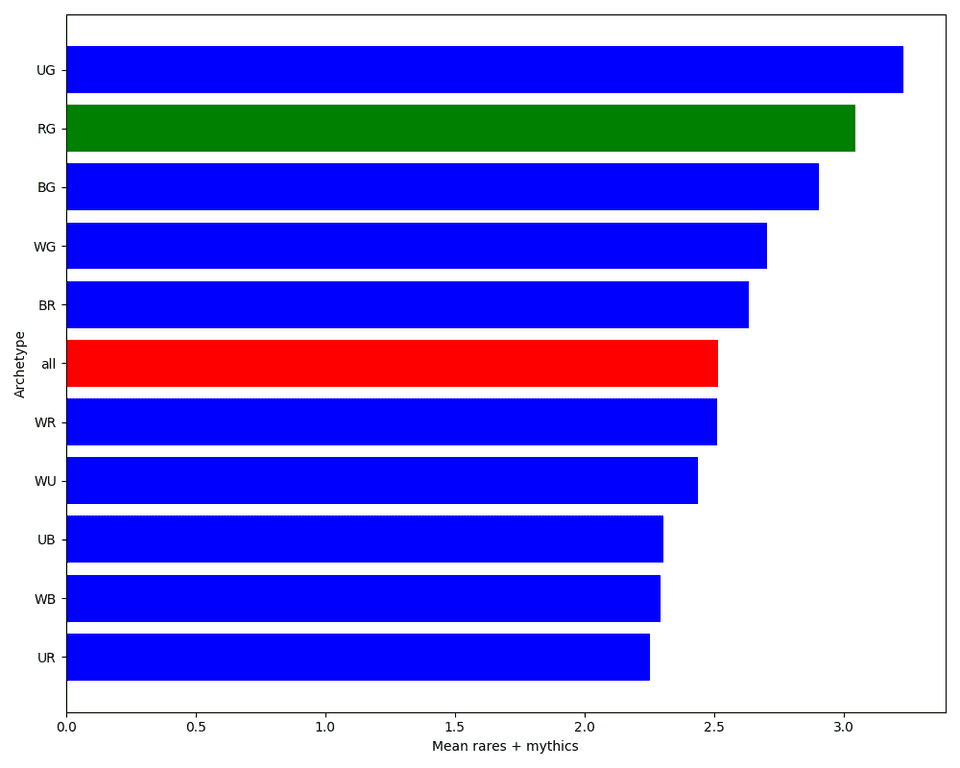
As you can see, the green archetypes rely on rares the most with Gruul being the second most extreme case with an average of 3 rares per deck.
A quick look at the same chart for uncommons (avg. 8) and commons (avg. 12) shows that Gruuls’ commons are not particularly important.
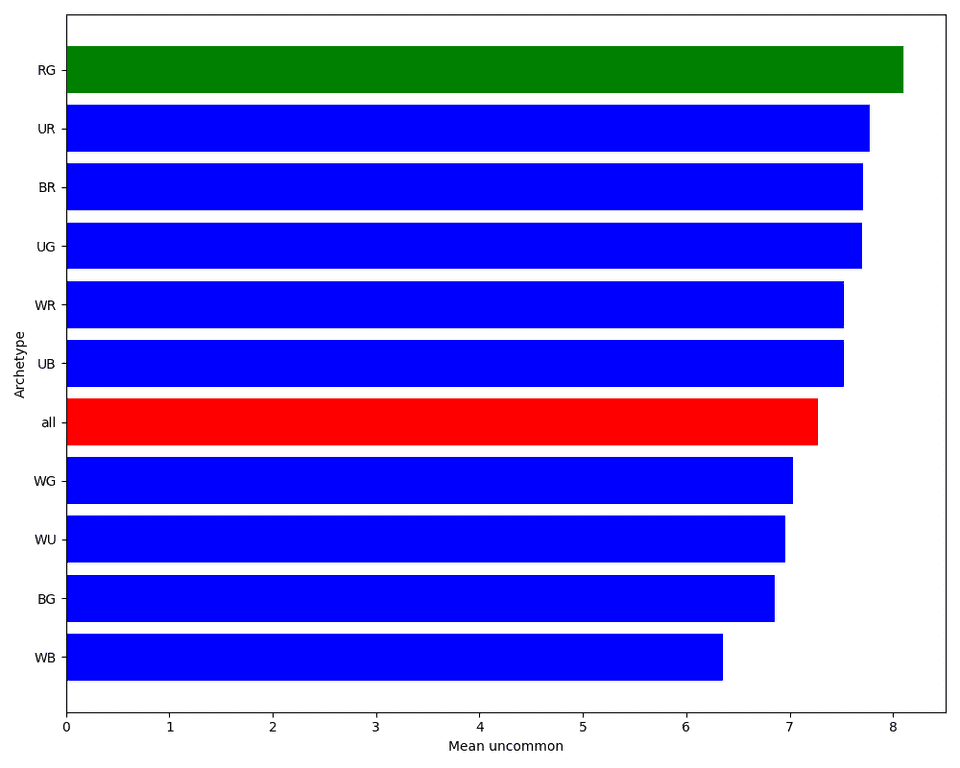
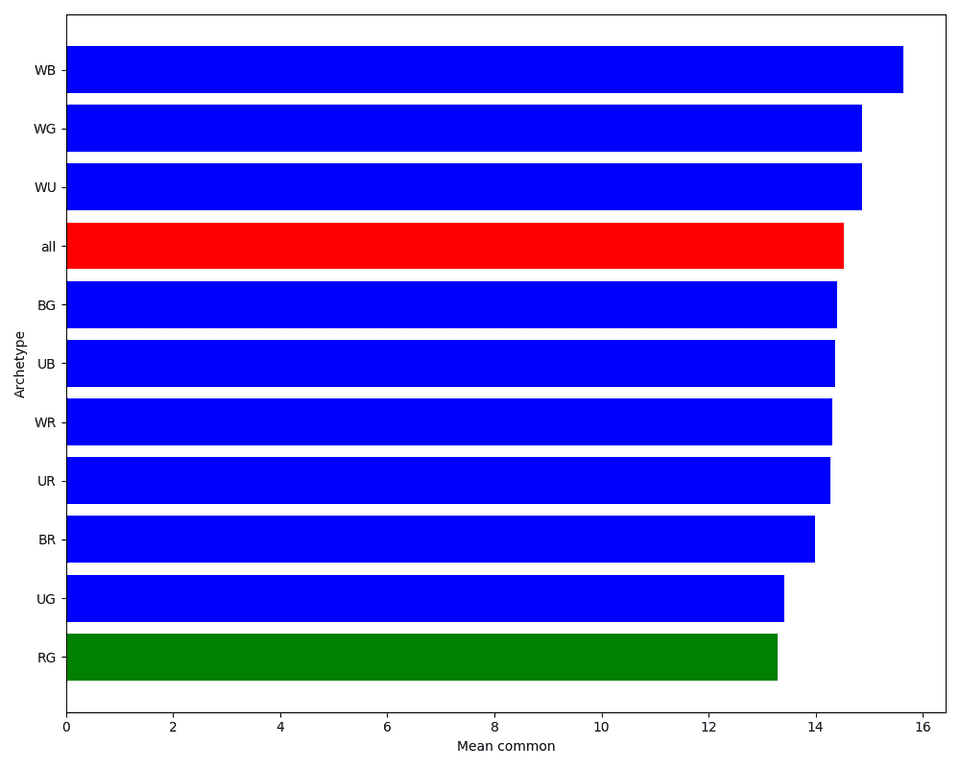
In conclusion, we see that red/green depends on higher rarities to be successful. Be aware not to move into the lane for commons.
Green vs. Red
Next we take a look at the color distribution in Gruul trophy decks.
The following chart shows the distribution of colored pips in each archetype.
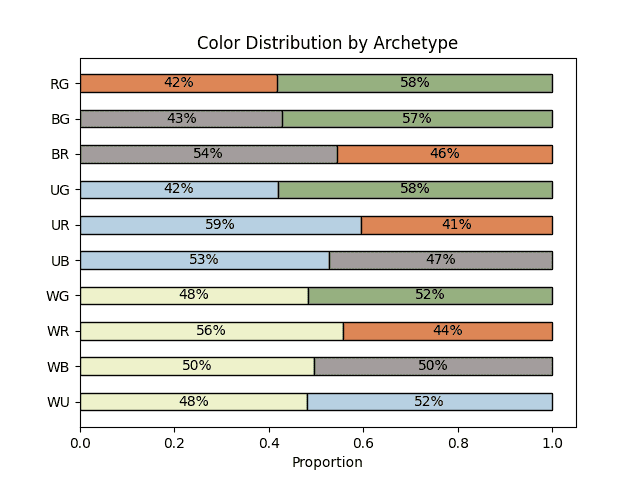
Creature Count and Curve
Let’s get to the final but also most important part of the analysis, the meat and bones of limited magic: creatures.
First let’s take a look at the average creature counts of each archetype.
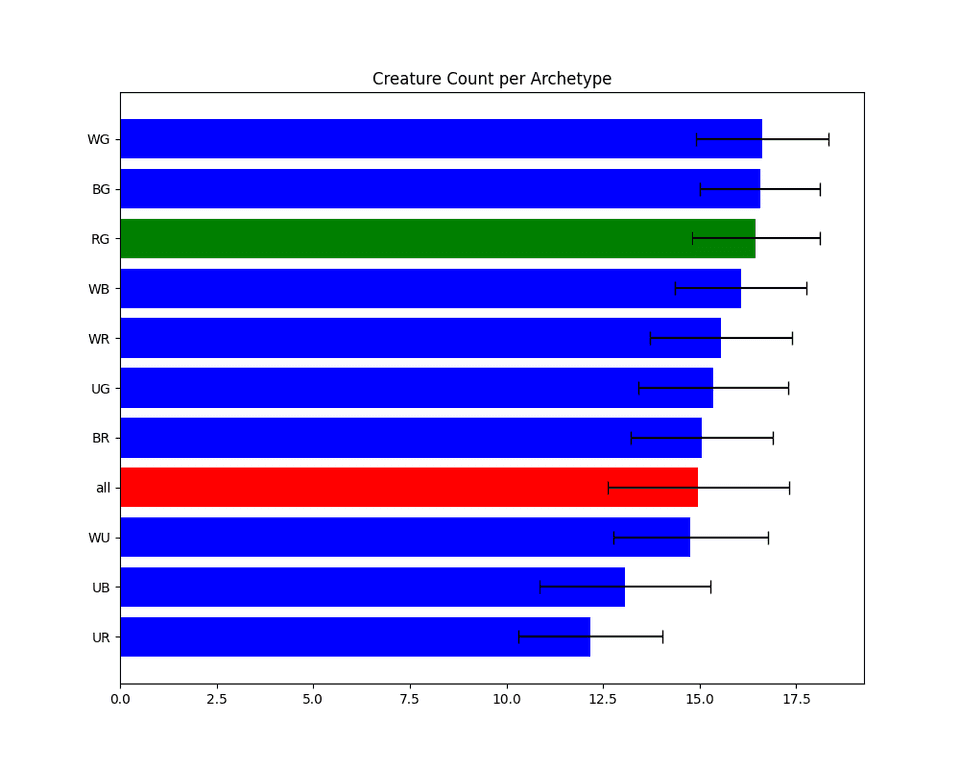
Looking at the curve we also see that the number of creatures at each mana cost is always a little higher than the overall average.
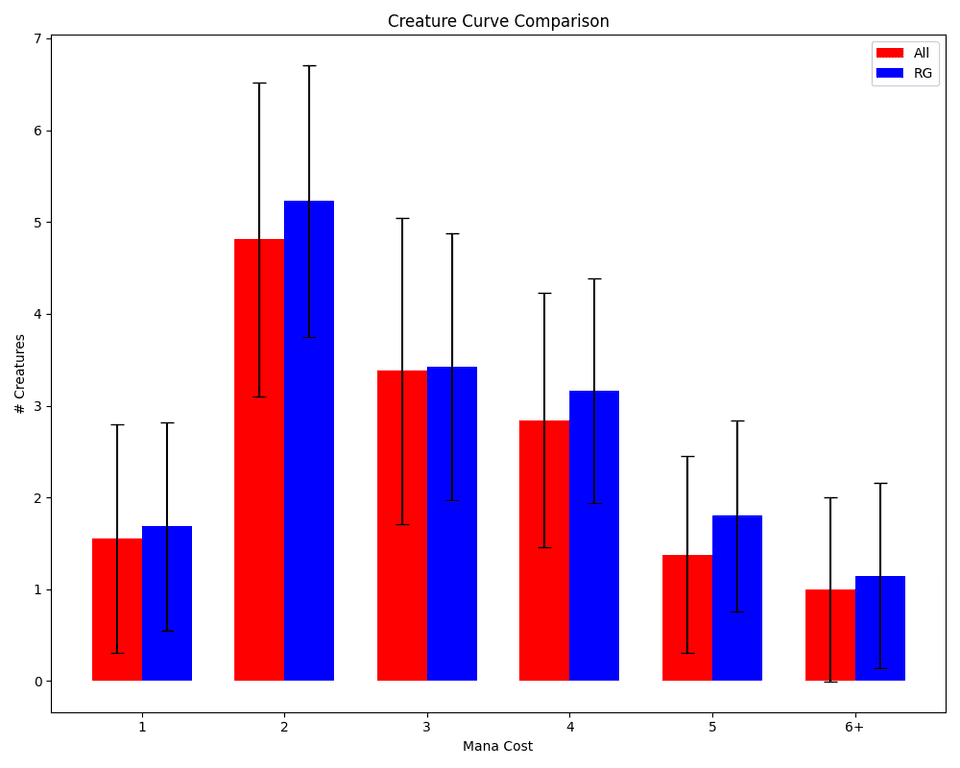
1-Drops
The average red/green trophy deck has 1.68 one-drops, but you don't just want any of the available ones. The most premium one is Kellan, Planar Trailblazer with an average win rate of 60.2%. Since Kellan is a rare and with an ALSA of 2.23 you won't see it that often, but it's worth first-picking, since it's good in any of the red archetypes.
More realistically you'll be looking for Llanowar Elves and Mild-Mannered Librarian to fill your one-drop slots. Llanowar Elves in particular seems like an essential card for Gruuls' success with a high average of 0.9 copies in trophy decks. This high occurrence plus having an ALSA of 3.42, making it the fifth-highest picked common in the set, suggests to me that you really don't want to be fighting with other people on the table of the good green cards.
| Name | Rarity | Avg. # in decks | Game in Hand WR | ALSA |
|---|---|---|---|---|
| Kellan, Planar Trailblazer | rare | 0.15 | 60.2% | 2.23 |
| Llanowar Elves | common | 0.9 | 58.1% | 3.42 |
| Mild-Mannered Librarian | uncommon | 0.3 | 57.8% | 4.36 |
| Frenzied Goblin | uncommon | 0.11 | 54.3% | 6.19 |
| Fanatical Firebrand | common | 0.17 | 51.9% | 6.92 |
| Wildwood Scourge | uncommon | 0.05 | 50.3% | 4.23 |
2-Drops
Two-drops are the biggest part of the curve in Gruul with an average of 5.2 cards in trophy decks. The most common ones are Ruby, Daring Tracker and Courageous Goblin, both with an average of 0.8 copies in trophy decks. Ruby, Daring Tracker performs well card with a game in hand win rate of 57.5% and a relatively high ALSA, since it's a gold card and no one else should be interested in it. Courageous Goblin looks more like a filler card with a win rate below the archetypes average.
Looking at the two-drop table shows what we've seen previously, that the archetype needs higher rarities to be successful. Based on win rate alone, each rare is better than every uncommon and the same goes for uncommons compared to commons. The only two-drops you really want to avoid are Firebrand Archer and Campus Guide since both of them only have 1 toughness, making it awkward with all the 1/1s running around.
| Name | Rarity | Avg. # in decks | Game in Hand WR | ALSA |
|---|---|---|---|---|
| Scavenging Ooze | rare | 0.21 | 62.9% | 1.97 |
| Searslicer Goblin | rare | 0.14 | 61.1% | 2.20 |
| Nessian Hornbeetle | uncommon | 0.47 | 58.5% | 3.50 |
| Heartfire Immolator | uncommon | 0.34 | 58.1% | 3.89 |
| Ruby, Daring Tracker | uncommon | 0.80 | 57.5% | 5.12 |
| Slumbering Cerberus | uncommon | 0.42 | 57.0% | 4.90 |
| Wary Thespian | common | 0.58 | 55.7% | 5.50 |
| Courageous Goblin | common | 0.83 | 55.2% | 6.62 |
| Dwynen's Elite | common | 0.38 | 54.6% | 5.61 |
| Gnarlid Colony | common | 0.60 | 53.9% | 5.42 |
| Axgard Cavalry | common | 0.38 | 53.3% | 7.10 |
| Firebrand Archer | common | 0.01 | 49.7% | 7.03 |
| Campus Guide | common | 0.04 | 47.6% | 6.72 |
3-Drops
Moving on to the three-drops, trophy decks have an average of 3.4 of them. Good choices among commons are Ambush Wolf and Beast-Kin Ranger, which both have an above average win rate and are the most popular three-drops in trophy decks. Both cards have high enough ALSA values to potentially wheel them.
Just like Ambush Wolf, Eager Trufflesnout is another 4/2 three-drop, enabling potential power-4-or-greater synergies. In a format where cheap interaction like Stab and Burst Lightning is premium this has the potential for a negative tempo swing. However, the opponent will not always have the answer right away, and the high win rate tells me that Gruul needs to take that risk to win.
| Name | Rarity | Avg. # in decks | Game in Hand WR | ALSA |
|---|---|---|---|---|
| Spinner of Souls | rare | 0.18 | 62.3% | 1.79 |
| Scrawling Crawler | rare | 0.04 | 59.3% | 2.17 |
| Eager Trufflesnout | uncommon | 0.45 | 59.2% | 4.41 |
| Ambush Wolf | common | 0.76 | 57.1% | 6.37 |
| Beast-Kin Ranger | common | 0.79 | 56.9% | 5.53 |
| Loot, Exuberant Explorer | rare | 0.15 | 55.9% | 2.17 |
| Goblin Boarders | common | 0.46 | 54.7% | 6.71 |
| Elvish Archdruid | rare | 0.10 | 53.9% | 3.01 |
| Mossborn Hydra | rare | 0.07 | 53.2% | 1.93 |
| Brazen Scourge | uncommon | 0.15 | 52.7% | 5.23 |
| Flamewake Phoenix | rare | 0.09 | 51.8% | 2.74 |
| Reclamation Sage | uncommon | 0.11 | 49.7% | 4.96 |
| Firespitter Whelp | uncommon | 0.02 | 48.9% | 4.92 |
| Burnished Hart | uncommon | 0.01 | 46.7% | 5.33 |
4-Drops
Right next on the curve are the four drops, which we ideally want 3.2 of in our deck. Looking at the above average win rate four drops, tells us pretty well what the archetype wants to do. For Elvish Regrower and Cackling Prowler it's beneficial trading your three-drop and getting some value from that, also opening up potential blow-outs with combat tricks, in case of blocks. Battlesong Berserker on the other hand might enable a good attack, which your opponent didn't consider. All of them scream "attack", other more value or long-game-oriented creatures like Krenko, Mob Boss or Solemn Simulacrum are lower in win rate.
One card that stands out is Sower of Chaos. Not to say that it's a good card, but it has a win rate that is actually not worse than the archetype average. Given that it ALSA value suggest that it is often the last card in the pack, this might be a good pickup which you don't have to be embarrassed about.
However, what also sticks out is that Treetop Snarespinner is the second most played 4-drop in red/green, which given its win rate seems like a mistake. While the mana sink ability is nice, the card is just too slow and the initial body not relevant for attacking.
| Name | Rarity | Avg. # in decks | Game in Hand WR | ALSA |
|---|---|---|---|---|
| Ashroot Animist | rare | 0.42 | 60.5% | 3.05 |
| Elvish Regrower | uncommon | 0.42 | 58.4% | 3.22 |
| Battlesong Berserker | uncommon | 0.42 | 57.9% | 4.36 |
| Cackling Prowler | common | 0.58 | 57.1% | 6.07 |
| Sower of Chaos | common | 0.22 | 56.2% | 8.14 |
| Strongbox Raider | uncommon | 0.36 | 56.1% | 4.83 |
| Krenko, Mob Boss | rare | 0.14 | 55.2% | 2.16 |
| Solemn Simulacrum | rare | 0.04 | 54.4% | 1.74 |
| Treetop Snarespinner | common | 0.48 | 53.7% | 5.12 |
| Dwynen, Gilt-Leaf Daen | uncommon | 0.11 | 53.1% | 4.45 |
| Juggernaut | uncommon | 0.05 | 50.7% | 6.87 |
| Spitfire Lagac | common | 0.01 | 50.1% | 8.23 |
5-Drops
For the 1.7 five-drops in your red/green deck you can't really do much wrong. Gorehorn Raider is a common with a relatively high ALSA, so most times you should be able to pick one up. Besides that the only thing to pay attention is to avoid Elfsworn Giant, which does not fit the archetype's game plan.
| Name | Rarity | Avg. # in decks | Game in Hand WR | ALSA |
|---|---|---|---|---|
| Twinflame Tyrant | mythic | 0.09 | 60.0% | 1.61 |
| Dragon Trainer | uncommon | 0.37 | 57.9% | 4.00 |
| Gorehorn Raider | common | 0.73 | 56.8% | 6.69 |
| Needletooth Pack | uncommon | 0.32 | 56.1% | 4.01 |
| Elfsworn Giant | common | 0.26 | 53.5% | 5.99 |
6+ Drops
While the analysis shows that red/green trophy decks have 1.2 six-drops, the win rates of the potential creatures are a little disappointing. Affectionate Indrik is the only one with a win rate above the archetype average and for sure a good curve topper.
Given that even a card like Quilled Greatwurm is performing below average, while having a combat relevant ability, tells me that the archetype wants to have won by turn six. So if you end your draft with nothing on your 6+ mana slot, don't worry too much about it.
| Name | Rarity | Avg. # in decks | Game in Hand WR | ALSA |
|---|---|---|---|---|
| Affectionate Indrik | uncommon | 0.27 | 56.5% | 4.35 |
| Drakuseth, Maw of Flames | rare | 0.09 | 56.0% | 2.68 |
| Ghalta, Primal Hunger | rare | 0.17 | 55.7% | 2.21 |
| Quilled Greatwurm | mythic | 0.09 | 55.7% | 1.60 |
| Quakestrider Ceratops | uncommon | 0.09 | 55.5% | 5.70 |
| Etali, Primal Storm | rare | 0.12 | 54.9% | 2.09 |
| Apothecary Stomper | common | 0.15 | 53.2% | 6.73 |
| Shivan Dragon | uncommon | 0.17 | 53.2% | 5.27 |
| Meteor Golem | uncommon | 0.03 | 52.7% | 5.25 |
Non-creature spells
So now that we’ve looked at the curve and how to best choose our ideal 16.4 creatures, let’s take a look at the remaining 6.6 slots. We’ll look at removal, combat tricks, and lands separately.
If you get a chance to pick up Sylvan Scavenging you should take it. It's the best payoff for having a creature with power 4 or greater and asks nothing of you. The tempo loss of not playing a creature on the board is quickly made up by creating 3/3s for free for the rest of the game.
Other than that you're only really interested in the two on-color playneswalkers and Leyline Axe. All the other cards have subpar win rates.
Expecially the enchantment Garruk's Uprising looks like a trap in the archetype. While it seems like a decent payoff for what the archetype supposedly wants to do, the win rate is quite bad. My guess is that playing this in the earlier turns is not putting enough pressure on the opponent and later you're not getting enough triggers of it to make it worth it.
Another trap is Heraldic Banner. While it has decent stats for some archetypes (e.g. white/blue), here it's win rate is abysmal.
| Name | Rarity | Avg. # in decks | Game in Hand WR | ALSA |
|---|---|---|---|---|
| Sylvan Scavenging | rare | 0.20 | 63.7% | 1.81 |
| Vivien Reid | mythic | 0.06 | 63.1% | 1.51 |
| Chandra, Flameshaper | mythic | 0.08 | 62.9% | 1.62 |
| Leyline Axe | rare | 0.11 | 61.9% | 1.97 |
| Goldvein Pick | common | 0.14 | 53.0% | 5.65 |
| Garruk's Uprising | uncommon | 0.31 | 52.8% | 4.83 |
| Involuntary Employment | common | 0.04 | 51.3% | 7.29 |
| Thrill of Possibility | common | 0.07 | 50.4% | 7.34 |
| Heraldic Banner | uncommon | 0.08 | 48.8% | 4.71 |
| Grow from the Ashes | common | 0.11 | 46.3% | 6.33 |
Removal
The average trophy deck play 4.08 removal spells, but not all of them are equally good.
The best one is Felling Blow, which not only removes a creature but also puts a +1/+1 counter on one of yours. This can shift the board state dramatically and therefor makes up for not being instant speed.
All the other removal spells in the top tier are instant speed and cheap. Burst Lightning, Fiery Annihilation, Abrade and Bite Down are all premium removal spells and you play as many as you can get.
Just be mindful when playing bite spells against open blue mana that you're opponent could have Run Away Together and blow you out.
| Name | Rarity | Avg. # in decks | Game in Hand WR | ALSA |
|---|---|---|---|---|
| Felling Blow | uncommon | 0.45 | 60.1% | 3.31 |
| Burst Lightning | common | 1.10 | 59.4% | 3.32 |
| Fiery Annihilation | uncommon | 0.44 | 58.7% | 2.98 |
| Abrade | uncommon | 0.33 | 57.9% | 3.00 |
| Bite Down | common | 0.87 | 57.0% | 4.08 |
| Slagstorm | rare | 0.03 | 54.7% | 3.55 |
| Bushwhack | common | 0.54 | 53.6% | 4.84 |
| Incinerating Blast | common | 0.23 | 53.1% | 7.09 |
| Broken Wings | common | 0.05 | 50.8% | 7.76 |
| Goblin Negotiation | uncommon | 0.04 | 50.4% | 5.82 |
Combat Tricks
None of the combat tricks shine with their win rates in red/green, but they still make up 1.44 card on average in trophy decks.
Snakeskin Veil is the best with an almost average win rate. It's a good card to have a copy of in your deck, due to its cheap cost and versatility of protecting against a removal spell as well as winning combat.
Giant Growth is the most played combat trick in red/green and even though the win rate is below average, it's not embarrassingly low. Its high ALSA makes it a good card to pick up on the wheel.
In general, you’ll be more likely to play these cards when you’re low on removal or they synergize particular well with the other cards you picked.
| Name | Rarity | Avg. # in decks | Game in Hand WR | ALSA |
|---|---|---|---|---|
| Snakeskin Veil | uncommon | 0.28 | 56.0% | 4.52 |
| Giant Growth | common | 0.57 | 55.0% | 6.67 |
| Overrun | uncommon | 0.27 | 53.4% | 4.48 |
| Preposterous Proportions | rare | 0.04 | 53.3% | 4.42 |
| Sure Strike | common | 0.18 | 52.7% | 7.50 |
| Bulk Up | uncommon | 0.01 | 50.6% | 6.89 |
| Goblin Surprise | common | 0.09 | 49.1% | 6.35 |
Lands
Lastly let’s look at some lands. Red/green trophy decks play on average 16.6 lands, of which 15.6 are basics (8.2 forests and 7.4 mountains) and 1 are non-basics.
A hidden gem in this deck is Rogue's Passage, with a game in hand win rate of 57.9%, which is extremely high for a land. It's an excellent card to have in your deck, since you're creatures have a high power, so sneaking in one through the defenses goes a long way. Make sure you'll pick one up during the draft as it gives your deck a way out of board stalls.
Be careful with how many tapped lands you're playing. As you can see in the table below Rugged Highlands and Evolving Wilds both decrease you're win rate on average. Not to say that you shouldn't play them at all, since there definitely are double pip cards you want to play, but don't overdo it.
| Name | Rarity | Avg. # in decks | Game in Hand WR | ALSA |
|---|---|---|---|---|
| Rogue's Passage | uncommon | 0.11 | 57.9% | 6.65 |
| Soulstone Sanctuary | rare | 0.06 | 56.9% | 3.64 |
| Rugged Highlands | common | 0.58 | 55.3% | 7.11 |
| Evolving Wilds | common | 0.29 | 54.5% | 4.72 |
Conclusion
Gruul in Foundations presents a fascinating contradiction: while green is often dismissed as the weakest color, its pairing with red results in one of the format’s strongest archetypes. By understanding the archetype’s unique characteristics — its reliance on a high density of creatures, preference for rares, and the pitfalls of splashing — you can draft Gruul with confidence.
This article with its tables showed you the composition of successful Gruul decks and can serve as a reference for your next draft.
While I wouldn’t recommend forcing Gruul, since we saw that it relies on rares and uncommons, it’s a great tool in your arsenal to have when you see green is open.